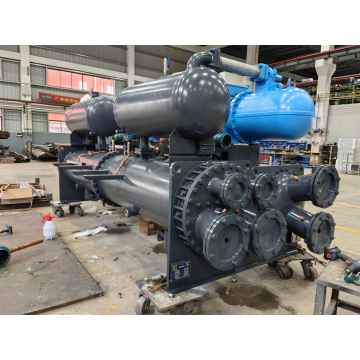
The structure and working process of dry evaporator
The refrigerant of the dry evaporator passes through the heat exchange tube, and the cold water runs outside the high-efficiency heat exchange tube. The heat exchange efficiency of such a heat exchanger is relatively low, and its heat transfer coefficient is only about 2 times that of the light tube. However, The advantage is that it facilitates oil return and is relatively simple to control, and the refrigerant filling amount is about 1/2 to 1/3 of the filling amount of the liquid-filled unit.
Structure and working process of flooded evaporator
The operation mode of a flooded evaporator is exactly the opposite of that of a dry evaporator. Cold water passes through the heat exchange tubes, and the refrigerant completely immerses the heat exchange tubes. After absorbing heat, it evaporates outside the heat exchange tubes. There are many pin-shaped holes on the surface of the heat transfer tube of the flooded evaporator, and there are spiral protrusions on the inner surface of the tube to enhance heat exchange on the cold water side. This high-efficiency heat transfer tube, which simultaneously enhances boiling outside the tube and heat transfer inside the tube, increases the heat transfer coefficient by about 5 times compared with plain tubes.
Advantages and disadvantages of dry and flooded evaporators
The flooded evaporator has water flowing inside the tubes, and the refrigerant evaporates outside the tube clusters, so the heat transfer surface is basically in contact with the liquid refrigerant. Generally, the amount of refrigerant filled in the shell is about 55% to 65% of the effective volume of the cylinder. After the refrigerant liquid absorbs heat and vaporizes, it passes through the liquid separator on the top of the cylinder and returns to the compressor. Easy operation and management, high heat transfer coefficient.
shortcoming:
① When the evaporation temperature of the refrigeration system is lower than 0°C, the water in the tube is easy to freeze and damage the evaporation tube;
② Large refrigerant charging capacity;
③Affected by the height of the refrigerant liquid column, the evaporation temperature at the bottom of the cylinder is higher, which will reduce the heat transfer temperature difference;
④ Oil will accumulate in the lower part of the evaporator barrel, and reliable oil return measures must be taken, otherwise the safe operation of the system will be affected.
In a dry evaporator, refrigerant flows inside the tubes and water flows outside the tube clusters. The flow of refrigerant usually has several processes. Due to the gradual vaporization of the refrigerant liquid, the number of process tubes is usually greater as it goes upward. In order to increase the heat transfer on the water side, several baffles are provided on the outside of the cylinder heat transfer tube to allow water to flow across the tube cluster multiple times.
advantage:
① The lubricating oil enters the compressor with the refrigerant, and there is generally no problem of oil accumulation.
② The amount of refrigerant charged is small, generally only about 1/3 of the full liquid type;
③When t0 is near 0℃, water will not freeze.




![]() February 23, 2024
February 23, 2024 The structure and working process of dry evaporator
The structure and working process of dry evaporator